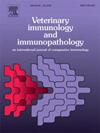Expanding tropism: Avian B cells as novel cellular target of infectious bronchitis virus
IF 1.4
3区 农林科学
Q4 IMMUNOLOGY
引用次数: 0
Abstract
Infectious bronchitis virus (IBV) causes infectious bronchitis (IB), which is a major concern for the global poultry industry as a result of substantial economic losses. Although epithelial cells were described as the primary target cells of IBV, other susceptible cell types including macrophages and monocytes, have been identified, where productive infection impairs cellular functions. Avian B cells are central to antibody-mediated immunity in chickens against pathogens, including IBV; however, it remains unknown if IBV can infect and replicate in B cells. This study investigated whether Delmarva (DMV)/1639 IBV can infect B cells in the bursa of Fabricius (BF) in vivo and in DT–40 cells in vitro. In vivo, a significantly higher viral genome load was observed in the BF at 3 days post-infection (dpi), with similar result in sorted B cells from the BF. Viral RNA was found to be localized within B cells of the BF using an in situ hybridization combined with immunohistochemistry. In vitro, a comparable trend in viral genome load was observed in infected DT–40 cells and culture supernatants up to 72 h post-infection (hpi). Immunofluorescence assay revealed a significantly higher percentage of DT–40 cells expressing IBV nucleoprotein. Inoculation of DT-40 cells with virus-containing supernatant confirmed infectivity as did inoculation of embryonated eggs, which resulted in IBV-specific lesions including dwarfing and stunting. These findings demonstrate that IBV can infect and replicate productively in avian B cells; however further studies are warranted to elucidate the impact of IBV infection on B cell function and its role in disease pathogenesis.
趋向性扩展:禽B细胞是传染性支气管炎病毒的新细胞靶点。
传染性支气管炎病毒(IBV)引起传染性支气管炎(IB),这是全球家禽业关注的一个主要问题,造成了巨大的经济损失。虽然上皮细胞被描述为IBV的主要靶细胞,但其他易感细胞类型,包括巨噬细胞和单核细胞,已被确定,其中生产性感染损害细胞功能。禽B细胞是鸡对病原体(包括IBV)的抗体介导免疫的核心;然而,IBV是否能感染B细胞并在B细胞中复制尚不清楚。本实验研究了Delmarva (DMV)/1639 IBV是否能在体内感染法氏囊(BF) B细胞,并在体外感染DT-40细胞。在体内,在感染后3天(dpi), BF中观察到明显更高的病毒基因组载量,从BF中分类的B细胞也有类似的结果。利用原位杂交结合免疫组化技术,发现病毒RNA在BF的B细胞内定位。在体外,在感染后72 h (hpi)感染的DT-40细胞和培养上清中观察到病毒基因组负荷的类似趋势。免疫荧光分析显示,表达IBV核蛋白的DT-40细胞比例显著提高。用含病毒的上清液接种DT-40细胞证实了感染能力,接种胚卵也证实了感染能力,导致ibv特异性病变,包括矮化和发育迟缓。这些结果表明,IBV可以感染并在禽B细胞中高效复制;然而,IBV感染对B细胞功能的影响及其在疾病发病机制中的作用有待进一步研究。
本文章由计算机程序翻译,如有差异,请以英文原文为准。
求助全文
约1分钟内获得全文
求助全文
来源期刊
CiteScore
3.40
自引率
5.60%
发文量
79
审稿时长
70 days
期刊介绍:
The journal reports basic, comparative and clinical immunology as they pertain to the animal species designated here: livestock, poultry, and fish species that are major food animals and companion animals such as cats, dogs, horses and camels, and wildlife species that act as reservoirs for food, companion or human infectious diseases, or as models for human disease.
Rodent models of infectious diseases that are of importance in the animal species indicated above,when the disease requires a level of containment that is not readily available for larger animal experimentation (ABSL3), will be considered. Papers on rabbits, lizards, guinea pigs, badgers, armadillos, elephants, antelope, and buffalo will be reviewed if the research advances our fundamental understanding of immunology, or if they act as a reservoir of infectious disease for the primary animal species designated above, or for humans. Manuscripts employing other species will be reviewed if justified as fitting into the categories above.
The following topics are appropriate: biology of cells and mechanisms of the immune system, immunochemistry, immunodeficiencies, immunodiagnosis, immunogenetics, immunopathology, immunology of infectious disease and tumors, immunoprophylaxis including vaccine development and delivery, immunological aspects of pregnancy including passive immunity, autoimmuity, neuroimmunology, and transplanatation immunology. Manuscripts that describe new genes and development of tools such as monoclonal antibodies are also of interest when part of a larger biological study. Studies employing extracts or constituents (plant extracts, feed additives or microbiome) must be sufficiently defined to be reproduced in other laboratories and also provide evidence for possible mechanisms and not simply show an effect on the immune system.

 求助内容:
求助内容: 应助结果提醒方式:
应助结果提醒方式:


